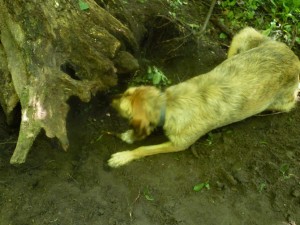Spring Bee Hiving Moon
The dogs have gone to the kennel, a place they enjoy. Vega, though, our biggest and  sweetest, was hurt when we left them for 40 days and 40 nights while the good ship Veendam cruised around South America. It took her a few days to warm back up to us. Since you can’t tell a dog how long you’re going to be gone, she might expect equally long stays each time she goes now. I hope not because hurting her hurts me, too.
sweetest, was hurt when we left them for 40 days and 40 nights while the good ship Veendam cruised around South America. It took her a few days to warm back up to us. Since you can’t tell a dog how long you’re going to be gone, she might expect equally long stays each time she goes now. I hope not because hurting her hurts me, too.
I stayed behind while Kate handled the dogs because I had to bring all the bee hive woodenware into the garage. I didn’t have the heart to do it when I investigated on Monday. So all we have left is loading the truck when Kate gets back, then its scenic Iowa and Nebraska. Be still my wanderer’s heart.
The flipside of the flat and somewhat monotonous nature of the plains is the ease with which they’re driven. I feel a bit traitorous calling them monotonous anyhow. Yes, south of here, down into Iowa, the land evens out. And, yes, it stretches flat for a long enough time to be called a plain. But its beauty opens itself only slowly and to one willing to look for it instead of just wanting to be done with it.
Especially in the fall, when the grains have not yet been harvested and the fields are golden against the blue skies and especially in the summer when the fields are green and the thunderheads mount the horizon like bulls about to ride the cowboy, the plains can reach the deepest levels of beauty. Winter is not their best season when the fields are brown, the trees leafless and the livestock huddles around water and food stores. Then, they look forlorn, abandoned, perhaps a place best gotten through quickly. In early spring, now, when the field have just been plowed, there is a furrowed beauty, too. In spite of what I know about traditional agriculture.
Well, soon. We’ll be in it ourselves, headed toward the outer limits of our great Midwest, the Rocky Mountains.
